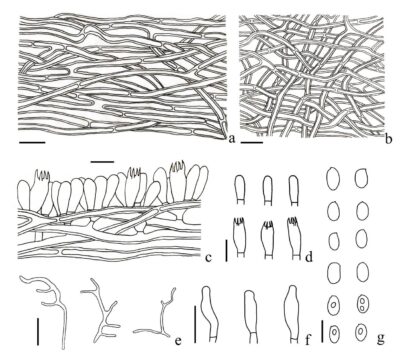Fungalpedia – Note 379, Phlebiporia
Phlebiporia Jia J. Chen, B.K. Cui & Y.C. Dai
Citation when using this data: Tibpromma et al. 2024 (in prep.) – Fungalpedia, Macrofungi.
Index Fungorum, Facesoffungi, MycoBank, GenBank, Fig. 1
Classification: Meruliaceae, Polyporales, Incertae sedis, Agaricomycetes, Agaricomycotina, Basidiomycota, Fungi.
Based on phylogenetic analyses phylogenies of ITS and LSU, analyses and morphological studies, Chen and Cui (2014) proposed Phlebiporia in Meruliaceae to accommodate the type species Phlebiporia bubalina. Phlebiporia characterized by an annual, resupinate basidiomata, strongly attached to the substrate, a monomitic hyphal system with simple-septate, dextrinoid and thick-walled generative hyphae, presence of thin-walled quasi-binding hyphae in the subiculum, and small, smooth, ellipsoid basidiospores, IKI–, CB– (Chen & Cui 2014). Phlebiporia is unique in its dextrinoid generative and quasi-binding hyphae (Chen & Cui 2014). No other species have been introduced to this genus, which remains monotypic.
Type species: Phlebiporia bubalina Jia J. Chen, B.K. Cui & Y.C. Dai
Other accepted species: This genus is monotypic.
Figure 1 – Phlebiporia bubalina. a Hyphae from trama. b Hyphae from subiculum. c Basidiome part section. d Basidia and basidioles. e Quasi-binding hyphae. f Cystidioles. g Basidiospores. Scale bars: a-f = 10 µm, g = 5 µm. Redrawn from Chen & Cui (2014).
Reference
Entry by
Du TY, Center for Yunnan Plateau Biological Resources Protection and Utilization, College of Biological Resource and Food Engineering, Qujing Normal University, Qujing, Yunnan 655011, China; Center of Excellence in Fungal Research, Mae Fah Luang University, Chiang Rai 57100, Thailand; School of Science, Mae Fah Luang University, Chiang Rai 57100, Thailand.
(Edited by Saowaluck Tibpromma, Samaneh Chaharmiri-Dokhaharani, & Achala R. Rathnayaka)
Published online 25 November 2024
